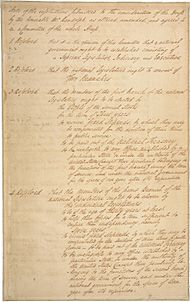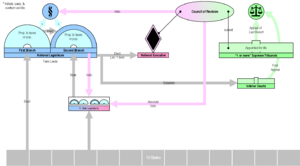Virginia Plan facts for kids
Quick facts for kids Virginia Plan |
|
 Front side of the Virginia Plan 1787
|
|
| Created | May 29, 1787 |
| Location | National Archives |
| Authors | James Madison |
| Purpose | Propose a structure of government to the Philadelphia Convention |
The Virginia Plan was a big idea for how the United States government should work. It was also called the Randolph Plan or the Large-State Plan. This plan was shared at the Constitutional Convention in 1787.
The Virginia Plan suggested creating a strong national government. This government would have three main parts, or branches. It also wanted a two-part legislature, which is like having two houses of Congress. James Madison and Edmund Randolph helped write this important plan.
The Virginia Plan was very important because it set the stage for many debates at the Convention. It introduced the idea that states should have votes in Congress based on their population. This meant states with more people would have more power. The Virginia Plan was good for states with large populations. Because of this, the New Jersey Plan was later suggested to protect the interests of smaller states.
Contents
Why a New Plan Was Needed
From May to September 1787, leaders met in Philadelphia. This meeting was called the Constitutional Convention. Their goal was to fix the Articles of Confederation. The Articles were the first plan for the United States government.
Many people thought the Articles made the central government too weak. The Confederation Congress could not raise taxes to pay for a military. It also struggled to pay off money owed to other countries. The Congress could not control trade between states or with other nations. Plus, there were no executive (president) or judicial (court) branches. This meant the government could not easily make states follow its laws.
James Madison's Ideas
James Madison, a leader from Virginia, believed the U.S. needed a strong central government. He thought Congress should be able to collect taxes. It also needed power to control trade. Madison wanted a way to make sure national laws were followed. He thought there should be a national court system.
Madison also believed that Congress should have power over citizens directly. This was different from the Articles, where Congress only worked through the states. He felt that states should have votes in Congress based on their population. This would give bigger states more say.
Madison also worried about a "tyranny of the majority". This is when a large group might unfairly control the government. He thought a national government with many different groups would be fairer. To protect national power and minority rights, Madison believed Congress should be able to stop state laws.
How the Plan Was Created
While waiting for the Convention to start, Madison worked on the Virginia Plan. He talked with leaders from Virginia and Pennsylvania. Virginia's governor, Edmund Randolph, shared Madison's ideas for a strong government.
Madison often gets credit for the plan. But Randolph added many important parts. He was also the one who officially presented the plan to the Convention. This happened on May 29, 1787. Randolph explained the problems the country faced. He warned of "anarchy" (chaos) if the government stayed weak. He said the solution must be based on "republican principles." This means a government where people elect their leaders.
Key Ideas of the Virginia Plan
The Virginia Plan was a big change from the Articles of Confederation. It suggested creating a powerful national government. It was based on how state governments worked. The plan called for three branches of government:
- The executive branch (like a president)
- The legislative branch (like Congress)
- The judicial branch (like courts)
However, the plan did not have the "checks and balances" system we have today. In the Virginia Plan, the legislature chose the executive and judicial branches. The plan was presented as fifteen main ideas, or resolutions.
Here are some of the main ideas:
- The Articles of Confederation needed to be fixed or replaced. The Virginia Plan was really a replacement.
- States would get votes in the national legislature based on their wealth or population. This would give larger states more power than smaller ones. This is why it was called the "large-state plan."
- The single-chamber Congress under the Articles should be replaced. Instead, there would be a two-part legislature.
- People would elect members of the first part of the legislature. This would become the House of Representatives.
- The first part of the legislature would choose members for the second part. This would become the Senate. State legislatures would suggest candidates.
- The national legislature would have all the powers of the old Congress. It would also get new powers. These included making laws for things states could not handle. It could also stop any state law that went against national laws.
- The national legislature would choose a national executive (leader). This leader would serve one term. They would carry out national laws.
- The executive and some judges would form a "council of revision." This group could stop laws made by the national or state legislatures. But the national legislature could overrule their decision.
- There would be a national court system. It would include a supreme court and lower courts. Judges would serve as long as they did a good job. The courts would handle cases like piracy, crimes at sea, and issues between states. They would also handle impeachment of national officials.
- New states could join the Union.
- The United States would make sure each state had a republican government.
- There would be a way to change the Constitution without needing the national legislature's approval.
- State officials would promise to support the new Constitution.
- The people would vote to approve the new Constitution.
How People Reacted
Larger states liked the Virginia Plan. But smaller states did not. They wanted each state to have equal votes, no matter its population.
On June 15, 1787, the smaller states suggested the New Jersey Plan. This plan wanted a single-chamber legislature. Each state would have one vote, just like under the Articles of Confederation.
In July, the Convention found a middle ground. This was called the Connecticut Compromise. It created a House of Representatives where votes were based on population. And it created a Senate where each state had equal representation.


